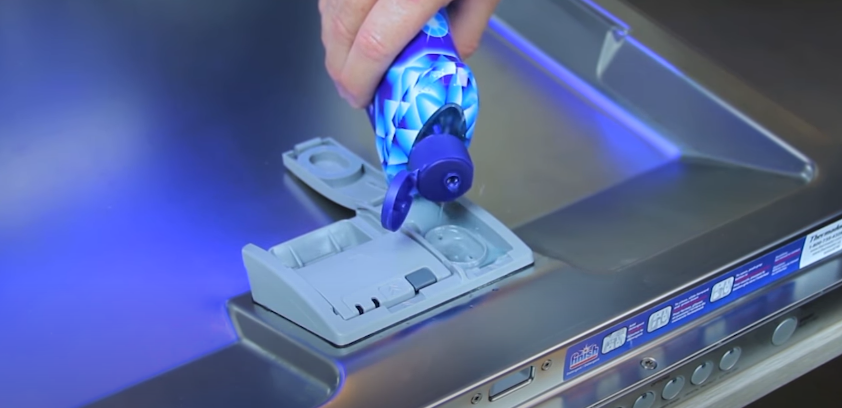
Rinse aid is a liquid you add to dishwashers. It helps dishes dry better and stops water spots on glassware. It lowers water’s surface tension. This helps it flow off surfaces better.
Using a rinse aid in a dishwasher helps with drying. It also removes streaks and makes your dishes shine without spots.
Step 1: Locate the Rinse Aid Dispenser
The rinse aid dispenser is located in the dishwasher door. It is usually next to the detergent compartment. Look for a cap labelled “Rinse Aid” or a droplet icon. Different dishwasher models can have the dispenser in different spots. So, check your user manual if you need help.
- Most dishwashers have a rinse aid dispenser close to the detergent slot. This makes it easy to access.
- If your dishwasher doesn’t have a dispenser, you can use a rinse aid basket. You can also switch to a detergent that has rinse aid included.
Step 2: Open the dispenser cap
To add rinse aid, twist or press the dispenser cap open. Most dishwashers use a twist-off cap, while others have a push-latch system. Carefully remove the cap to avoid spills.
- Dishwasher rinse aid caps differ by brand. Most open by turning counterclockwise or pressing a button.
- If the dispenser cap is stuck, use a dry cloth for a better grip. You can also check your user manual for opening instructions.
Step 3: Fill the Dispenser with Rinse Aid
Pour rinse aid into the dispenser until it reaches the max fill line. Use a small funnel to prevent spills and avoid overfilling, as excess rinse aid can cause foaming.
- Most rinse aid dispensers can hold enough liquid for several washes. So, you do not need to refill them after each wash.
- Pick a good rinse aid for the best drying and streak-free dishes, especially with hard water.
Step 4: Clean Up Any Spills
If rinse aid spills during filling, wipe it immediately with a damp cloth. This prevents excess foaming and ensures a smooth dishwasher cycle.
- Spilled rinse aid can create unnecessary suds, which can affect dishwasher performance.
- Check and clean around the dispenser often. This helps to stop buildup that can block proper dispensing.
Step 5: Close the Dispenser Cap Securely
Twist or press the dispenser cap back into place until it clicks. A sealed cap stops leaks and ensures the rinse aid is used correctly in the wash cycle.
- If the cap doesn’t close properly, check for debris. Clean the dispenser opening before sealing.
- Most dishwashers have a light or a clear window. This shows when rinse aid levels are low, so refill them as needed.
Bonus Tips for Using Rinse Aid Efficiently
Adjust the Rinse Aid Dispenser Setting
Many dishwashers allow you to adjust how much rinse aid is released per cycle. If you notice streaks or cloudy glassware, adjust the dispenser setting to use more or less rinse aid.
- Higher settings let out more rinse aid. This is useful for hard water and dirty dishes.
- Lower settings use less rinse aid. This can be better for soft water, as it helps avoid too much buildup.
Refill Rinse Aid Regularly
Dishwashers with an indicator light or clear window help to track rinse aid levels. Check these indicators frequently to maintain optimal performance.
- A low rinse aid level can result in poor drying, leaving dishes with water spots.
- For the best results, top up rinse aid at least once a month. You can do this more often if you use your dishwasher frequently.
Final Thoughts: Why Rinse Aid Matters
Using rinse aid in a dishwasher helps dishes dry better. It also stops streaks and keeps them spot-free. It’s a key additive that boosts dishwasher performance, particularly in hard water areas. Refilling and adjusting your rinse aid dispenser often keeps your dishes sparkling clean.
Here are five easy steps to use rinse aid and get the best results from your dishwasher!







